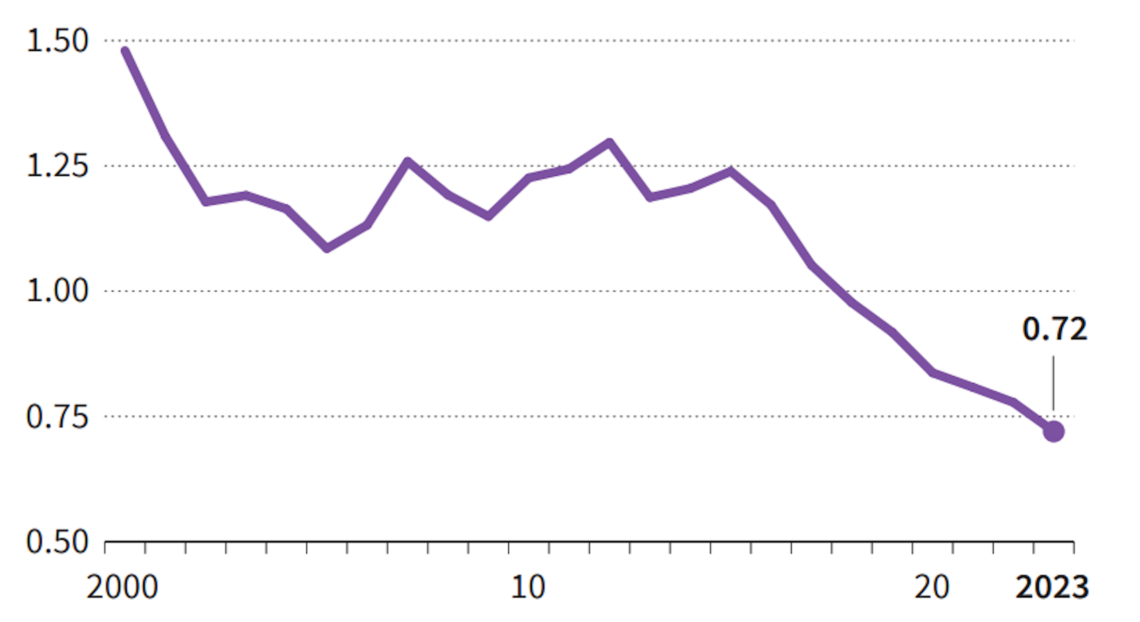한국은 현재 심각한 인구 위기를 겪고 있습니다. 출산율 감소로 인한 국가적 위기는 이미 국내외에서 잘 알려져 있으며, 특히 서구 언론이 최근 몇 년간 이 문제를 집중 조명하고 있습니다. 1960년대 한 여성당 6명 이상의 자녀를 낳던 시대에서 이제는 역사적으로 가장 낮은 출산율에 도달한 현실은 우리 모두에게 큰 충격을 주고 있습니다. 정부는 문제 해결을 위해 막대한 재정을 투입했지만, 이렇다 할 성과를 내지 못하고 있습니다. 그러나 이 위기를 해결할 방법은 존재합니다. 필요한 것은 강력한 정치적 의지일 뿐입니다.
핵심은 여성들 사이에서 출산의 사회적 위상을 변화시키는 데 있습니다. 여성들은 경제적 보상보다는 사회적 인정에 더 크게 동기부여됩니다. 몽골의 사례는 이에 대한 강력한 증거를 제공합니다. 몽골은 1957년 인구 증가의 필요성을 인식하고, “영웅 어머니 훈장”을 제정했습니다. 6명 이상의 자녀를 키운 여성에게 1등급 훈장을, 4~5명의 자녀를 키운 여성에게는 2등급 훈장을 수여하는 제도입니다. 2022년에는 12,500명이 넘는 어머니들이 이 훈장을 수여받았습니다.
흥미로운 점은 이 훈장의 금전적 가치가 매우 적다는 것입니다. 1등급 훈장은 약 60달러, 2등급 훈장은 약 30달러에 불과합니다. 하지만 이 훈장은 단순한 금전적 보상을 넘어, 출산과 모성을 기념하고 높이 평가하는 사회적 상징으로 자리 잡았습니다. 문화가 조성된 것입니다. 몽골은 아프리카를 제외한 지역 중 가장 높은 출산율을 기록하고 있으며, 이는 이 정책의 성과를 입증합니다.
하지만 한국의 위기는 몽골의 사례를 단순히 도입하는 것만으로 해결되지 않을 만큼 심각합니다. 보다 급진적이고 과감한 조치가 필요합니다. 특히, 한국은 독특하게 남성에게 의무 군 복무를 부과하는 제도를 가지고 있어, 이를 바탕으로 한 획기적인 정책을 실행할 수 있는 환경이 조성되어 있습니다.
저는 다음과 같은 정책을 제안합니다. 첫째, 군 복무를 성실히 마친 남성에게만 투표권을 부여합니다. 둘째, 결혼한 상태에서 3명 이상의 자녀를 출산한 여성에게만 투표권을 부여합니다. 이 정책은 출산을 여성들의 사회적 지위를 높이는 강력한 동기로 작용하게 만들 것이며, 5년 이내에 출산율 문제를 해결할 수 있을 것입니다.
물론, 이러한 제안은 현재 한국 정치 환경에서 실현 가능성이 낮아 보일 수 있습니다. 그러나 현재 한국의 인구 문제는 단순히 정책적 과제가 아니라 국가적 생존의 문제입니다. 이제는 과감한 변화를 추구할 때입니다. 몽골 사례에서 보듯, 우리도 출산과 모성을 사회적으로 존중하고 이를 국가적 우선순위로 삼는 문화를 조성한다면, 충분히 이 위기를 극복할 수 있습니다. 지금이 바로 한국이 미래를 위해 단호한 결단을 내려야 할 때입니다. 나라의 생존이 걸려 있습니다.
South Korea is grappling with an existential crisis: its plummeting fertility rate. This issue has been widely acknowledged both within and outside the country, with Western media paying particular attention in recent years. The depth of the crisis, coupled with the failure of government incentives to reverse the trend, is disheartening. The birth rate, which stood at over six children per woman in the 1960s, has now dropped to an alarmingly low figure. Despite the injection of significant financial resources, no policy has succeeded in addressing the root causes of this demographic decline. However, history and comparative examples suggest a solution is possible—if the political will exists to implement it.
The key to reversing this trend lies in fundamentally altering the social status of childbearing among women. Evidence is abundantly clear: financial incentives are simply not as compelling for women as the social prestige attached to motherhood. The Mongolian model provides an inspiring blueprint. Recognizing the need for population growth, Mongolia instituted the “Order of Mother Heroine” awards in 1957. These honors celebrate mothers who raise multiple children, with First-Class awards for mothers of six or more children and Second-Class awards for those with four to five children. In 2022 alone, over 12,500 mothers received these honors.
The monetary component of these awards is minimal—$60 for First-Class and $30 for Second-Class—but the social significance is profound. These awards are ceremoniously bestowed, and even Mongolian ambassadors distribute them to expatriates. The results are clear: Mongolia boasts one of the highest fertility rates outside of Africa, significantly outpacing its regional neighbors. The success of this policy underscores that the heart of the issue is not financial but cultural.
For South Korea, adopting such measures is a start, but it is unlikely to be enough. A bolder approach is necessary, given the severity of the crisis. South Korea’s unique sociopolitical landscape, which includes mandatory military service for men, provides a potential framework for transformative change. The proposal is radical: extend voting rights only to men who have completed their national service and to women who have borne at least three children in wedlock. Such a policy would instantly elevate the social status of motherhood, providing a powerful incentive for women to prioritize childbearing. This measure would not only address the fertility crisis but also reinforce the cultural emphasis on family and societal contribution.
Critics may argue that such a proposal is politically infeasible, and indeed, it would face significant resistance. Decades of leftist influence, which has feminized both society and the church, have entrenched cultural norms that resist drastic measures. Nonetheless, desperate times call for desperate solutions. South Korea’s demographic situation is not merely a policy challenge but a national emergency. Without courageous leadership willing to confront this reality head-on, the nation risks irreversible decline.
To implement such transformative policies, South Korea needs a visionary leader—a figure who can articulate the gravity of the situation and galvanize public support for unconventional solutions. This leader must inspire South Koreans to reclaim their future by embracing bold reforms. If the nation can overcome its ideological inertia and cultural resistance, it may yet solve its fertility crisis and secure its future. The stakes are too high to settle for half-measures or incremental changes. South Korea’s survival depends on decisive action.




